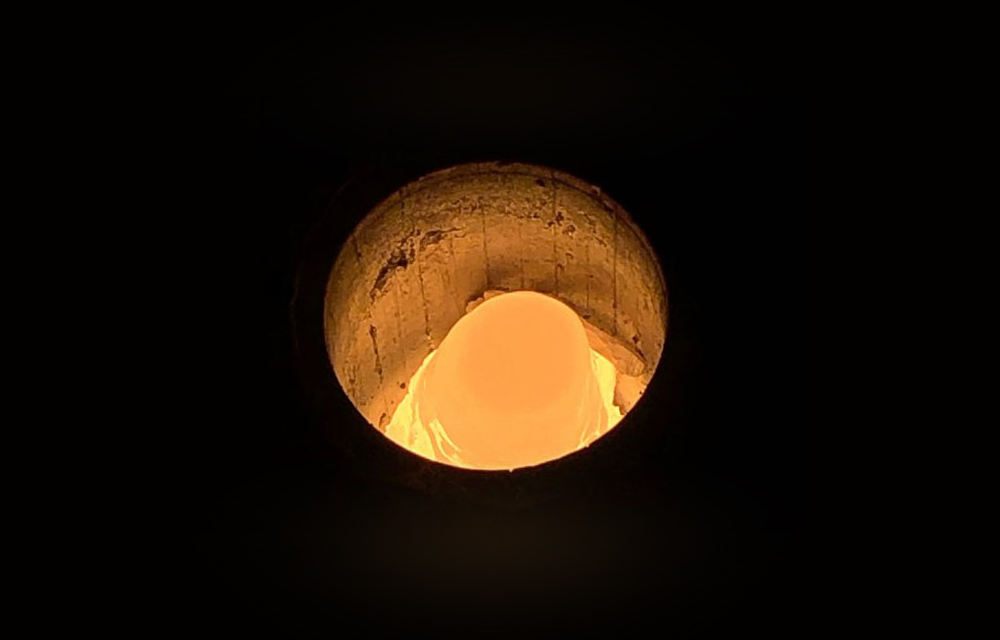High-temperature materials are an essential component in all technical applications in which components are permanently exposed to extreme temperatures. Since the efficiency of thermal processes, such as in aircraft engines, depends directly on the process temperature, the further development of high-performance materials is essential.
High-temperature materials
One important application of high-temperature materials are high-pressure turbine blades of aircraft engines. They are the first components to be exposed to the hot gas flow from the combustion chamber. During operation, they are subjected not only to temperatures of more than 1000 °C but also to enormous mechanical stresses. Currently, such high-performance components are mainly made of nickel-base superalloys, which are characterized in particular by their excellent creep behavior and corrosion resistance. To further increase the efficiency of aircraft engines, it is necessary to raise the operating temperature. However, nickel-base superalloys are limited to operating temperatures of up to 1150 °C. The development of new alloys for high-temperature applications is therefore of particular interest for further increasing efficiency.
Alloy systems based on niobium and silicon offer great potential to replace conventional nickel-base superalloys for high-temperature applications. Scientists at the Institut für Werkstoffkunde (IW, Materials Science) of Leibniz University Hannover are researching on this new generation of high-temperature alloys as part of a project funded by the Deutsche Forschungsgemeinschaft (DFG, German Research Foundation).
High-temperature alloys based on niobium-silicon
Alloys based on niobium and silicon have a high melting point (above 1750 °C), a comparatively low density (6.6 – 7.2 g/cm3) and very good high-temperature strength.
The so-called niobium-MASC systems (Metal And Silicide Composites) are characterized by their special microstructure, which is composed of a ductile Nb solid solution matrix (NbSS) and brittle silicides (Nb5Si3, Nb3Si) distributed therein. The property profiles of the two phases complement each other: the Nb matrix provides good fracture toughness, whereas the silicides are responsible for the high-temperature strength and oxidation resistance in the material.
To further harmonize the properties, current research is focusing on alloying with other elements. It has already been possible to significantly improve properties such as creep resistance and fracture toughness by adding titanium, chromium, aluminum and hafnium. Nevertheless, the practical application of Nb-MASC alloys is currently limited, for example, by their low fracture toughness at room temperature, so that methods for increasing and adapting strength and toughness have gained particular attention in recent years.
IW scientists are concerned with the question of what effect particle reinforcement has on the formation of the microstructure and the associated mechanical properties. In order to investigate this question, alloys are first produced at the IW in very small quantities using an arc melting process, and high-melting particles in the nanometer range are added. The mechanism of action of the particles is then investigated by means of extensive analyses and test procedures.
High-purity alloys through levitated melting
For successful particle reinforcement, it is essential that the particles are evenly distributed in the alloy. In order to meet this requirement, the production of Nb-MASC alloys in a cold wall induction crucible under semi-levitation is being tested for the first time as part of the project. To this end, IW is working closely with the Institut für Elektroprozesstechnik (ETP, Electrical Process Engineering) at Leibniz University Hannover, which has various high-performance induction melting facilities. The advantages of the process, apart from the production of samples on a large scale, are the high purity of the alloys produced and the homogeneous element distribution.
A crucible consisting of water-cooled copper segments is used for the melting process. With the aid of an AC inductor, a magnetic field is generated which causes eddy currents within the crucible segments. The resulting secondary magnetic field induces eddy currents within the material and thus causes heating.
The widely differing melting points of the individual elements pose a challenge for the melting process. While aluminum melts at 660 °C and vaporizes at 1355 °C, niobium only enters the molten state at a temperature of 2469 °C. The melting point of the niobium is determined by the temperature at which the niobium is melted. By skilfully producing master alloys of two or more elements, the melting points can be adjusted to such an extent that ultimately joint melting of all components is possible.
The interaction between the electric current in the melt and the alternating magnetic field generates electromagnetic forces, the so-called Lorentz forces, which are crucial for the process. They cause a strong deformation of the free surface of the liquid metal, which means that the melt has only a limited contact area with the crucible. Due to the high heat dissipation, a thin protective layer of solidified melt forms at the crucible bottom, so that contamination of the melt by the reaction between the reactive refractory metals such as niobium or titanium with the crucible material is prevented.
Due to the circulating melt currents, this technology represents a promising approach for the necessary homogeneous distribution of the introduced particles and thus for the further development of niobium-MASC alloys.

